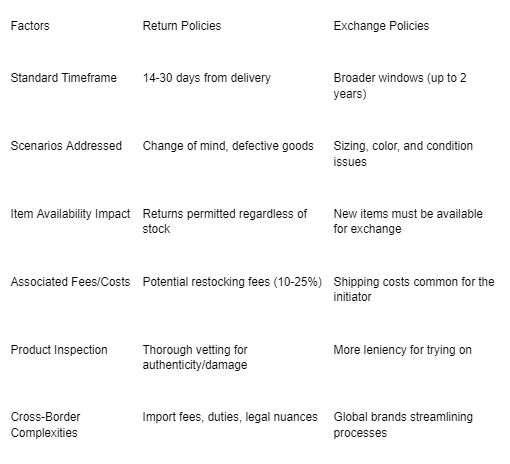Planning an unforgettable luxury getaway? You’ve likely invested time researching destinations, accommodations, and activities to curate your dream escape. But what about the finer details like return and exchange policies for the high-end travel accessories elevating your journey? These often-overlooked policies warrant consideration before splurging on designer luggage, apparel, or timepieces.
Today, we’ll explore the distinctions between return protocols and exchange procedures within luxury travel goods. Understanding these nuances can prevent frustration and protect your investment, whether you’re embarking on domestic or international adventures.
Overview of Return Policies for Luxury Travel Items
Standard Return Windows
Most luxury brands offer return windows 14 to 30 days from the delivery date for in-person or online purchases. This relatively narrow reconsideration period reflects the high-value nature of luxury items. Brands often implement stringent timelines to protect product integrity and resale value.
Watch Out for Restocking Fees
Even if you initiate a return within the designated time frame, be prepared for potential restocking fees. Many luxury houses deduct 10-25% from the refunded amount to offset the returned merchandise’s handling, inspection, and repackaging costs.
Product Specifics Matter
The type of luxury item can further impact return logistics. For instance:
- Hard Luxury Goods (Watches, Jewelry): These items are frequently inspected upon return to validate authenticity and condition. Expect thorough documentation requirements and longer processing times.
- Soft Luxury Goods (Apparel, Luggage): Return policies may permit leniency for trying on soft goods as long as the item is unused with intact tags and packaging. However, visible wear, alterations, or missing components can void the return.
To better understand the key distinctions between return vs exchange, let’s explore exchange policies in more depth.
Exchange Policies: Flexibility for Luxury Consumers
While return policies offer a strict window for reconsidering purchases, exchange procedures grant more flexibility. For the digitally-savvy 45-year-old Australian traveler frequenting Luxury Escapes, swapping sizes or colors can ensure the perfect travel ensemble.
When Exchanges Trump Returns
Exchanges often prevail when the product is desirable but requires minor adjustments.. Common scenarios include: incorrect size ordered for apparel or luggage, desire for an alternate color or material, or providing a gift recipient’s preferred variant
Rather than navigating a return and then re-purchasing, most luxury brands expedite an exchange to alleviate logistical hurdles and forge goodwill.
Generous Exchange Timelines
Although return periods are fixed, many high-end brands offer extended timelines for initiating exchanges post-purchase. For instance, luxury outerwear label Canada Goose permits exchanges for unworn items within two years of the original purchase date for a small fee.
Managing Inventory Availability
One downside is that exchanges hinge on the requested item being in stock. If a product is a seasonal or limited edition, the brand might deny an exchange due to unavailability. Planning is crucial for time-sensitive exchanges ahead of travel. Robust ecommerce inventory management systems and integrated customer experience software enable brands to handle these requests.
Comparison: High-End vs. Mainstream Travel Brands
How do dedicated luxury houses compare to mainstream travel brands regarding exchanges? Top-tier brands like Louis Vuitton often expedite exchanges more, even cross-border by leveraging specialized b2b e-commerce software. Whereas retail chains may pose more limitations or charges beyond an initial window.
Nuances in Policies for International Purchases
Understanding international return and exchange policies is paramount for the modern wanderlust-fueled explorer. Already grappling with customs and linguistic differences abroad, returns and exchanges introduce an extra logistical layer.
Obstacles to International Returns
Returning a luxury item purchased abroad presents three major challenges:
- Shipping Costs and Import Fees: Brands may require international returns be shipped at the customer’s expense and impose customs or duties upon re-entry.
- Localized Demand and Pricing: Regional product pricing and demand can affect whether a refund matches the original purchase amount.
- Legal Nuances: Differing consumer protection laws may impact return validity, processes, and associated fees across borders.
Global Brands Streamlining Processes
Many luxury brands are standardizing international policies and return portals to improve the cross-border customer experience. For instance, LVMH’s pamphlet covers worldwide returns and exchanges, streamlining once-fractured country processes.
Impact of Online Shopping on Return and Exchange Policies
As e-commerce redefined retail, online shopping for luxury goods sparked evolution within return and exchange practices… With online luxury sales booming, brands revisited existing policies.
Digital-First Purchase Mindset
Unlike visiting a boutique, online shoppers cannot inspect items in person before transacting. This digital-first mindset fuels expectations of hassle-free product returns if satisfaction wanes post-delivery.
Navigating Shipping Logistics
Return shipping costs and logistics become focal points for web purchases alongside the standard return windows. Most luxury e-tailers cover domestic return shipping while customers bear international expenses.
Comparison Table: Return vs. Exchange Policies
The table shows the key differences between returns and exchanges for luxury travel purchases to simplify parsing. It outlines critical factors:
Conclusion
Global wealth is increasing, and there are many travel opportunities. Being okay with luxury brand rules is key. Knowing a label’s return and exchange expectations doesn’t just protect your purchase; it fosters a cohesive, empowered experience that matches your investment.
Bridging gaps in understanding upfront removes surprises. These gaps concern processing fees, shipping, condition standards, and international hurdles. This allows your journey’s small delights to shine. These include sleek luggage and sumptuous apparel. They can now shine as intended, not be overshadowed by logistical woes.
Take pride in being an informed luxury consumer. Respect and advocate for your desires within brand rules. The path to your best travel memories should be smooth and amazing. They should be as great as the indulgences that make them great.
Published By: Aize Perez



















